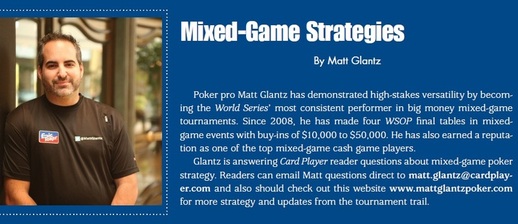






Mixed-Game Strategiesby Matt Glantz | Published: Jan 23, 2013 |
|
|

Q: In stud, how does the fact that there is no set position affect play? Since nobody is guaranteed to act last on the next street, how does that change your decision making?
A: There are not too many guarantees with regard to anything in poker. Just like other situations in poker you need to examine the limited information you do have available to make the best overall decision possible. In stud, your position is dictated by your up cards. The player with the highest ranking up hand will act first. Most of the time it is determined by the single highest up card, whoever has the card closest to the ace of spades. When a player has a pair on board or better, that will always trump the high card and force the player with the best pair or better to act first on subsequent streets. While it might initially seem totally random who is to act first later in the hand, you can always make assumptions based on your board versus your opponent’s board. From there you can see who is most likely to act first as the hand plays on. An easy example of this would be on fourth street your board is showing A-Q and your opponents board is showing 10-9. You would have acted first on fourth street due to your up cards and will be acting first on fifth street unless you experience the unlikely combination of your opponent pairing his ten or nine and you failing to pair either of your up cards.
Q: I’ve been thinking of starting a home game that features an eight-game mix format, with limits of $2-$4 for the fixed-limit games. What would you recommend as far as how to structure the big-bet games so that they aren’t playing way bigger than the limit ones? And also, what order do you think is the best?
A: When playing mixed games with limit, no-limit, and pot-limit games in the mix, it is a good idea to cap the big bet games. This is usually done for the long term reason of not losing players as frequently from the game. Without a cap you will lose players not only from players going broke at the table, but also from winning players that won’t feel comfortable risking their entire newly gained stack in a no-limit or pot-limit game. So what happens, unfortunately, in an uncapped game is your big losers go broke and your big winners just take their win and head for the exit.
Although it does vary when playing casino mixed games, a good general rule of thumb for the cap is between 10 and 15 times the big limit bet for the no-limit and pot-limit games. So in your case of a $2-$4 mixed game, you probably want to set your cap at $50. What this means is that in any no-limit or pot-limit game, each player can only put a max of $50 in the pot on all streets combined in any one hand. Even if a player starts the hand with $120 stack, he can only put $50 of their chips in the pot in any one hand and thus can only lose the $50.
When setting the blinds for your big bet games you have to decide what type of structure your players like to play. I would think the best way to start off in your scenario would be either two blinds of $1 with a $50 cap or a small blind of $.50 and a big blind of $1 with a $50 cap. That would make the no-limit and pot-limit games 50 blinds deep and create a good amount of action. The lower the blinds in relation to the cap will create less action. It is standard to set the cap anywhere from 50 to 100 times the big blind, and I would recommend starting off on the lower end to keep the game more active. If your players feel it is too big, you can always agree to lower the blinds to adjust.
The order of the games is best if you split up the games where you are dealt the same amount of cards per player in flop games and also split up the stud games so that no two are dealt in a row. When playing the standard 8-game mix we usually play in the following order and from my experience it keeps the game moving smoothly:
Limit hold’em, Omaha eight-or-better, razz, no-limit hold’em, stud, PLO, stud eight-or-better, deuce-to-seven triple draw ♠
Matt Glantz, Ambassador to Parx Poker Room (just outside Philadelphia, PA), is serving an integral role in the development of the fastest growing poker room on the East Coast. Matt has shown a consistent passion for growing the game of poker and has demonstrated high-stakes versatility, becoming the World Series’ most consistent performer in big money mixed-game tournaments. Since 2008, he has made four WSOP final tables in mixed game events with buy-ins of $10,000 to $50,000 and is considered one of the top mixed-game cash game players. For more strategy and updates from the tournament trail, check out www.mattglantzpoker.com
Features
The Inside Straight
Strategies & Analysis
Commentaries & Personalities